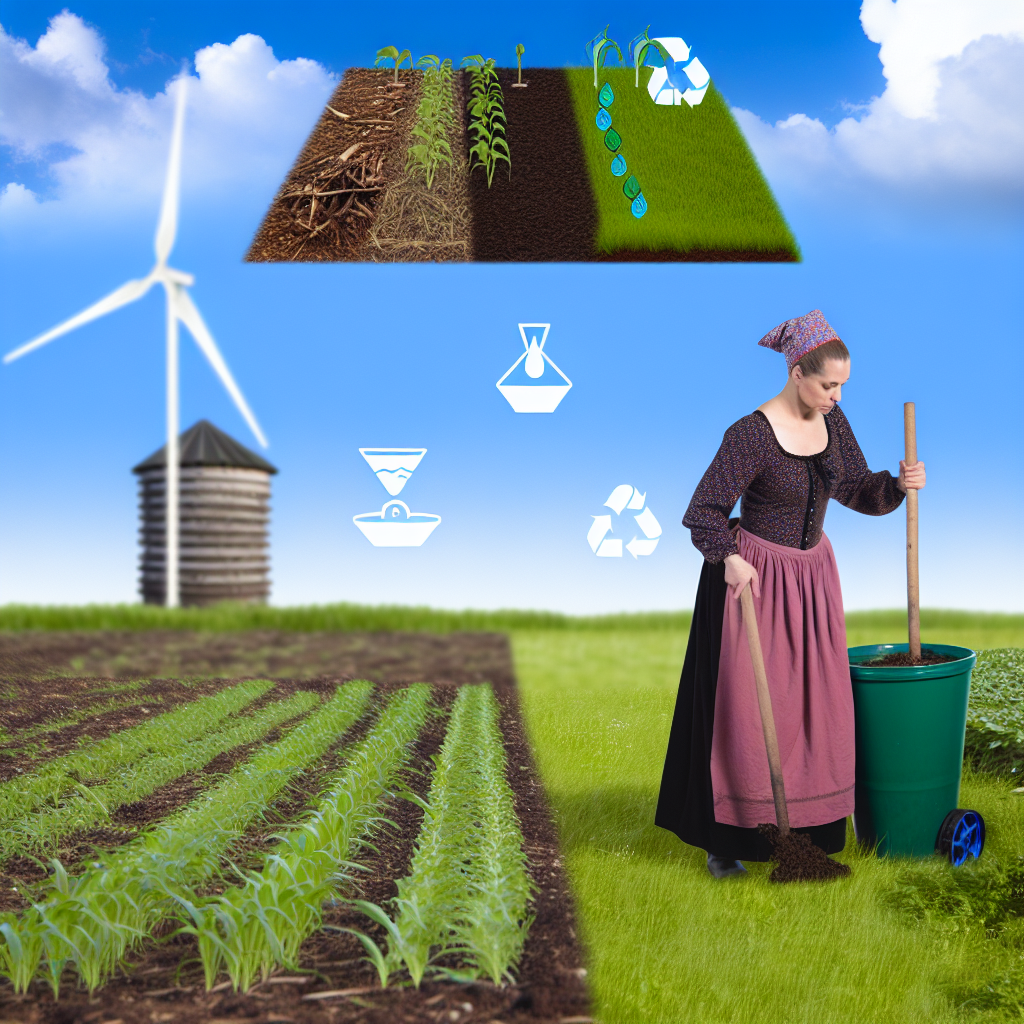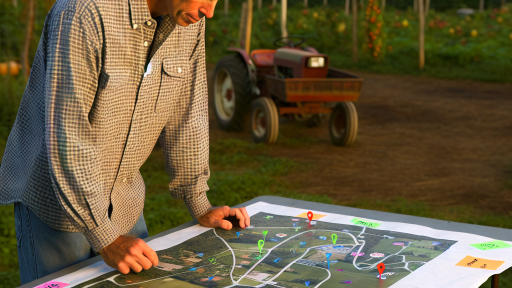Introduction to Sustainable Harvesting Methods
Sustainable harvesting methods benefit both farmers and the environment.
These techniques promote biodiversity and soil health.
Farmers can enhance their productivity while conserving resources.
Understanding Sustainable Practices
Sustainable practices prioritize long-term agricultural viability.
They reduce waste and optimize the use of natural resources.
Incorporating these methods leads to healthier ecosystems.
Benefits of Sustainable Harvesting
Farmers experience numerous advantages from sustainable harvesting.
- Improved crop yields.
- Reduced environmental impact.
- Enhanced soil fertility.
These benefits contribute to a more resilient agricultural system.
Adopting Innovative Techniques
Farmers can adopt various innovative techniques for sustainable harvesting.
For instance, agroforestry combines agriculture with forestry.
This practice improves biodiversity while boosting productivity.
Additionally, crop rotation prevents soil depletion.
Utilizing Technology in Harvesting
Technology plays a crucial role in sustainable harvesting methods.
Precision farming technologies optimize resource use.
GPS and drones can help monitor crop health effectively.
Transform Your Agribusiness
Unlock your farm's potential with expert advice tailored to your needs. Get actionable steps that drive real results.
Get StartedTraining and Education for Farmers
Education is essential for farmers to implement sustainable methods.
Workshops and training programs offer valuable resources.
These initiatives promote knowledge sharing among farmers.
As a result, they foster a community of practice focused on sustainability.
Importance of Sustainable Harvesting in Agriculture
Enhancing Environmental Health
Sustainable harvesting methods significantly improve environmental health.
They protect soil from erosion and degradation.
Moreover, these practices preserve water quality and availability.
Employing these techniques encourages biodiversity in farming systems.
As a result, ecosystems remain balanced and resilient.
Support for Economic Viability
Farmers experience improved economic stability through sustainable practices.
These methods reduce reliance on expensive chemical inputs.
They also enhance crop yields over time, securing farmers’ livelihoods.
In addition, markets increasingly prefer sustainably sourced products.
Farmers can access premium pricing through certifications for sustainable practices.
Community Well-Being and Food Security
Sustainable harvesting promotes community health and food security.
Farmers contribute to the local economy by using sustainable methods.
These practices ensure a consistent supply of nutritious food.
Furthermore, they help mitigate food scarcity during hard seasons.
Lastly, sustainable farming fosters community resilience against climate impacts.
Adapting to Climate Change
Climate change poses a significant threat to traditional agriculture.
Implementing sustainable harvesting techniques builds resilience.
These methods enhance soil carbon sequestration, combating climate change effects.
They also reduce greenhouse gas emissions associated with farming.
Overall, they enable farmers to adapt to changing weather patterns effectively.
Showcase Your Farming Business
Publish your professional farming services profile on our blog for a one-time fee of $200 and reach a dedicated audience of farmers and agribusiness owners.
Publish Your ProfileOverview of Different Sustainable Harvesting Techniques
Importance of Sustainable Harvesting
Sustainable harvesting protects ecosystems and maintains biodiversity.
It minimizes waste and conserves natural resources.
This approach is essential for long-term agricultural success.
Agroforestry Practices
Agroforestry combines agriculture and forestry practices.
This method enhances soil health and biodiversity.
Farmers can yield multiple products in a sustainable manner.
For instance, fruit trees can grow alongside crops.
Additionally, this practice provides shade and habitat for wildlife.
Crop Rotation Techniques
Crop rotation involves changing the type of crops grown in an area.
This technique helps break pest cycles and reduces soil depletion.
Farmers can improve soil fertility by alternating deep and shallow-rooted plants.
Furthermore, it promotes a balanced ecosystem within the fields.
No-Till and Reduced-Till Farming
No-till and reduced-till farming protect soil structure.
These methods reduce erosion and enhance moisture retention.
Farmers reduce fuel consumption and labor costs by minimizing tillage.
Consequently, they improve overall crop health and yields.
Cover Cropping
Cover crops prevent soil erosion during off-seasons.
They also suppress weeds and improve soil structure.
Farmers often use legumes to enhance nitrogen levels naturally.
This practice leads to healthier crops in subsequent planting seasons.
Integrated Pest Management
Integrated Pest Management (IPM) combines various pest control strategies.
This approach reduces reliance on chemical pesticides.
Farmers can utilize biological control methods and crop diversity.
Consequently, this method fosters a balanced ecosystem in farmland.
Community-Based Approaches
Community involvement enhances sustainable harvesting practices.
Local farmers share knowledge and resources through cooperatives.
This collaboration leads to better decision-making and sustainable practices.
By working together, communities can maintain agricultural resilience.
See Related Content: Agri-Tourism and Direct Sales: A Winning Combo
Soil Health Management for Sustainable Harvesting
Importance of Soil Health
Soil health plays a vital role in sustainable farming.
Healthy soil promotes crop growth and resilience.
Moreover, it enhances the overall ecosystem balance.
Practices to Improve Soil Health
Crop rotation encourages biodiversity and prevents nutrient depletion.
Cover cropping protects the soil from erosion during off-seasons.
Furthermore, it adds organic matter back into the soil.
Minimizing Soil Disturbance
Reduced tillage helps maintain soil structure.
This practice promotes water retention and nutrient availability.
Additionally, it decreases soil erosion and compaction.
Organic Matter and Soil Amendments
Adding compost improves soil texture and nutrient content.
Organic fertilizers enhance microbial activity in soil.
Showcase Your Farming Business
Publish your professional farming services profile on our blog for a one-time fee of $200 and reach a dedicated audience of farmers and agribusiness owners.
Publish Your ProfileAs a result, crops can access essential nutrients more efficiently.
Monitoring Soil Health
Regular soil testing informs farmers about nutrient levels.
This enables precise amendments based on specific needs.
Consequently, farmers can optimize their yield sustainably.
Uncover the Details: Eco-Friendly Fertilizers For Sustainable Agriculture
Water Conservation Strategies in Harvesting
Importance of Water Conservation
Water conservation plays a crucial role in sustainable farming practices.
It helps reduce waste and maintain crop health.
Moreover, conserving water enhances agricultural resilience against climate variability.
Efficient Irrigation Practices
Farmers can implement various irrigation techniques to save water.
Drip irrigation delivers water directly to plant roots.
This method minimizes evaporation and runoff.
Additionally, scheduling irrigation during cooler parts of the day prevents excessive loss.
Soil Management Techniques
Healthy soil retains moisture more effectively.
Farmers can use cover crops to improve soil structure.
These crops also enhance organic matter content, which aids water retention.
Furthermore, mulching protects soil from erosion and evaporation.
Rainwater Harvesting
Collecting rainwater is another effective conservation method.
Farmers can install rain barrels or cisterns for collection.
This water can be used for irrigation or livestock needs.
Implementing a rainwater harvesting system reduces dependency on groundwater.
Crop Selection and Rotation
Choosing drought-resistant crops can significantly reduce water needs.
These crops thrive on less water and are often more resilient to dry spells.
Rotating crops helps maintain soil health and moisture levels.
It prevents nutrient depletion and promotes overall crop sustainability.
Technological Innovations
Advancements in technology support water conservation efforts.
Soil moisture sensors help farmers monitor water needs accurately.
Automated irrigation systems can optimize water use.
By utilizing these tools, farmers can make data-driven decisions.
Find Out More: Sustainable Farming Through Agri-Tourism Practices
Use of Organic Fertilizers and Pest Control in Harvesting
Importance of Organic Fertilizers
Organic fertilizers enrich the soil with nutrients.
They improve soil structure and promote microbial activity.
This leads to healthier crops and better yields.
Farmers can source organic fertilizers from compost and manure.
These materials are often more sustainable than chemical options.
Efficient Application Techniques
Applying organic fertilizers requires precision.
Farmers should test their soil before application.
This helps in determining nutrient deficiencies.
Moreover, spreading fertilizer evenly ensures optimal absorption.
Using cover crops can also enhance soil fertility.
Pest Control Strategies
Utilizing natural pest control methods is vital.
Showcase Your Farming Business
Publish your professional farming services profile on our blog for a one-time fee of $200 and reach a dedicated audience of farmers and agribusiness owners.
Publish Your ProfileBeneficial insects can significantly reduce pest populations.
For example, ladybugs naturally control aphid numbers.
Farmers can also plant pest-repellent herbs.
These include marigolds and lavender, which deter harmful insects.
Integrated Pest Management
Integrated Pest Management (IPM) combines various strategies.
This approach minimizes chemical use and promotes sustainability.
Farmers should monitor pest populations regularly.
They can use traps and visual inspections to assess threats.
IPM encourages the use of natural predators and resistant plant varieties.
Benefits of Organic Practices
Organic farming improves environmental health.
It reduces chemical runoff into water systems.
Consequently, this approach preserves local ecosystems.
Moreover, it enhances marketability as consumers prefer organic products.
Finally, farmers can achieve better resilience against climate change.
You Might Also Like: Integrating Livestock In Sustainable Farming Systems

Crop Rotation and Its Benefits for Sustainable Harvesting
Introduction to Crop Rotation
Crop rotation involves changing the type of crops grown in a specific area over time.
This practice helps maintain soil health and promotes biodiversity.
Farmers can optimize their yields while minimizing environmental impacts.
Enhancing Soil Fertility
One primary benefit of crop rotation is enhanced soil fertility.
Different crops have varying nutrient requirements.
By alternating crops, farmers can prevent nutrient depletion.
Additionally, legumes, such as beans, can fix nitrogen in the soil.
Pest and Disease Management
Crop rotation aids in managing pests and diseases.
Different plants attract different pests.
By rotating crops, farmers disrupt pest life cycles.
This method reduces reliance on chemical pesticides.
Weed Control
Crop rotation is an effective strategy for controlling weeds.
Planting different crops can hinder the growth of specific weeds.
Moreover, varied crop roots prevent weed establishment.
This natural competition enhances crop productivity.
Increased Biodiversity
Another significant advantage of crop rotation is increased biodiversity.
Diverse crops support a wider range of organisms in the ecosystem.
This biodiversity can enhance pollination and pest predator populations.
Consequently, it leads to healthier farms and better yields.
Improving Resilience to Climate Change
Crop rotation contributes to improved resilience to climate change.
Diverse cropping systems can adapt better to changing weather patterns.
Moreover, rotations can help manage water usage efficiently.
This flexibility is essential for sustainable farming practices.
Technological Innovations Supporting Sustainable Harvesting
Precision Agriculture Technologies
Precision agriculture enhances the efficiency of resource use in farming.
Farmers utilize GPS and IoT devices for accurate planting and harvesting.
Showcase Your Farming Business
Publish your professional farming services profile on our blog for a one-time fee of $200 and reach a dedicated audience of farmers and agribusiness owners.
Publish Your ProfileThese technologies minimize waste and improve crop yields.
Furthermore, drones assist in monitoring crop health from above.
They provide real-time data, enabling prompt decision-making.
Automated Harvesting Solutions
Automated harvesting machines increase operational efficiency.
They reduce the labor costs associated with manual harvesting.
Robotics and AI streamline the harvesting process significantly.
For example, harvesting robots can identify ripe crops with precision.
This capability reduces crop damage and increases overall yield.
Data Analysis and Management Systems
Data analysis plays a crucial role in sustainable harvesting.
Farmers can use software to analyze weather patterns and soil conditions.
This information helps them make informed decisions about planting and harvesting.
Additionally, data management systems optimize resource allocation.
These systems enhance profitability while ensuring sustainability.
Integrated Pest Management Technologies
Integrated pest management (IPM) relies on technology for effective pest control.
Farmers can use sensors to detect pest infestations early.
They employ targeted treatments, reducing the need for harmful chemicals.
As a result, this approach protects both crops and beneficial insects.
Moreover, it promotes a healthier ecosystem overall.
Energy-Efficient Machinery
Energy-efficient machinery transforms traditional harvesting methods.
These machines consume less fuel, lowering operational costs.
By using renewable energy sources, farmers can further reduce their carbon footprint.
Innovative designs improve durability and effectiveness in the field.
This technology contributes to a more sustainable farming environment.
Case Studies: Successful Implementation of Sustainable Harvesting
Introduction to Case Studies
Case studies reveal effective sustainable harvesting practices.
These examples highlight proven methods in agriculture.
Example of Organic Vegetable Farming
Green Fields Farm implemented crop rotation techniques.
This method improved soil health and productivity.
Farmers reported higher yields with diverse vegetable crops.
The farm reduced dependency on chemical fertilizers.
Impact on Local Ecosystem
Diverse crops attracted beneficial insects to the farm.
Consequently, pest populations decreased significantly.
As a result, Green Fields Farm saw an increase in pollination.
Integrated Pest Management
Brambleberry Farm adopted integrated pest management (IPM).
This strategy included biological controls and monitoring.
Farmers used natural predators to control pests.
Overall, they experienced reduced chemical pesticide use.
Results and Benefits
Brambleberry Farm reported healthier crops and soil.
Moreover, the farm’s profits increased over two years.
It also gained recognition within the local community.
Agroforestry Practices
Sunny Acres incorporated agroforestry into their operations.
Showcase Your Farming Business
Publish your professional farming services profile on our blog for a one-time fee of $200 and reach a dedicated audience of farmers and agribusiness owners.
Publish Your ProfileThe combination of trees and crops enhanced biodiversity.
Harvesting tree fruits complemented traditional crop harvesting.
This method improved the overall resilience of the farm.
Economic and Environmental Advantages
Sunny Acres enjoyed additional income from selling timber.
Furthermore, soil erosion decreased significantly.
This practice also helped retain more moisture in the soil.
Conservation Tillage
Evergreen Farms practiced conservation tillage techniques.
This approach minimized soil disturbance during harvesting.
Farmers adopted cover cropping to protect their fields.
As a result, they improved soil structure and fertility.
Long-Term Sustainability
Evergreen Farms witnessed a decline in weed growth.
Consequently, this led to reduced herbicide applications.
Farmers also benefited from lower labor costs.
Effective Sustainable Practices in Agriculture
These case studies indicate various effective practices.
Sustainable harvesting methods significantly impact productivity.
Additionally, they contribute positively to the environment.
Ultimately, they set a strong precedent for future farming.
Challenges and Solutions in Adopting Sustainable Harvesting Methods
Identifying Key Challenges
Farmers often face several challenges when adopting sustainable harvesting methods.
One major issue is the initial investment required for new equipment.
Additionally, training workers to use these sustainable practices can be time-consuming.
Climate change also introduces unpredictability to harvest cycles.
Furthermore, there can be resistance from traditional farming communities.
Market demand for sustainable products may not always be clear.
Addressing Financial Concerns
Financial barriers can discourage farmers from switching methods.
To mitigate this, government subsidies can play a crucial role.
Grant programs can help cover costs of new technology.
Farmers can also consider cooperative purchasing of equipment.
Additionally, accessing low-interest loans may provide necessary funds.
Improving Training and Education
Effective training programs are vital for successful adoption.
Farmers benefit from hands-on workshops and demonstrations.
Local agricultural extensions can provide invaluable resources and support.
Networking with other farmers fosters sharing of best practices.
Moreover, online courses can reach a wider audience than traditional classes.
Enhancing Market Access
Access to markets remains a challenge for sustainable farmers.
Building partnerships with local businesses can enhance visibility.
Transparent communication about methods reassures consumers.
Farmers can also explore direct-to-consumer sales channels.
Joining community-supported agriculture (CSA) programs can stabilize income.
Adapting to Climate Change
Climate change necessitates the adoption of flexible harvesting methods.
Farmers should use drought-resistant plants to combat water shortages.
Showcase Your Farming Business
Publish your professional farming services profile on our blog for a one-time fee of $200 and reach a dedicated audience of farmers and agribusiness owners.
Publish Your ProfileCrop diversity enhances resilience against environmental stressors.
Additionally, integrating technology can provide real-time weather data.
This data helps farmers make informed harvesting decisions.




